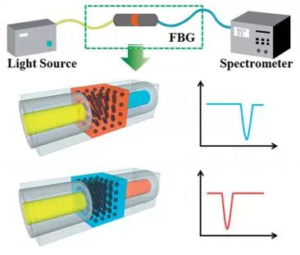 In order to make the fiber Bragg grating tunable (it means controlling the reflected wavelength), the Bragg grating period must be controllable. This is achieved by one of several methods. For example, the application of a stretching force elongates the fiber, which thus changes its period (mechanical tuning). Mechanical tuning of the FBG results in a faster and large response in terms of wavelength shift. The application of heat elongates the fiber, thus changing its period (thermal tuning). Changing the temperature of the FBG results in a slow wavelength shift; hence, a small tuning range is achieved. FBG final applications are in fiber dispersion compensation, in gain flattening of erbium-doped fiber amplifiers, and in add-drop multiplexers/demultiplexers. However, the fiber used to make an FBG should be free of imperfections as well as microscopic variations of the refractive index.
In order to make the fiber Bragg grating tunable (it means controlling the reflected wavelength), the Bragg grating period must be controllable. This is achieved by one of several methods. For example, the application of a stretching force elongates the fiber, which thus changes its period (mechanical tuning). Mechanical tuning of the FBG results in a faster and large response in terms of wavelength shift. The application of heat elongates the fiber, thus changing its period (thermal tuning). Changing the temperature of the FBG results in a slow wavelength shift; hence, a small tuning range is achieved. FBG final applications are in fiber dispersion compensation, in gain flattening of erbium-doped fiber amplifiers, and in add-drop multiplexers/demultiplexers. However, the fiber used to make an FBG should be free of imperfections as well as microscopic variations of the refractive index.
Tunable FBG is a valuable option for all applications that require flexibility in center wavelength (and/or frequency). The tuning setup consists of the mechanical assembly where the FBG is applied to. The mechanics induce strain to the FBG, shifting its center wavelength homogeneously and chirp-free.
Common FBGs have the flat top response, low cost, and low insertion loss that meets the requirement of add/drop FBG multiplexers in the optical WDM fiber transmission systems. However, a great deal of research interest in FBGs involves the property of being tunable in both the Bragg wavelength and bandwidth. Recent studies have shown large tuning ranges of 110 nm in the Bragg wavelength and more than 10 nm in the 3-dB bandwidth for uniform FBGs. Given such desirable tunability, FBG is becoming a very flexible and “smart” optical fiber component. Bandwidth-tunable FBG optical filters have been studied in many applications, such as tunable dispersion compensation, phased array antenna, and temperature-independent fiber grating sensing.
The important parameters of light sources for FBG interrogators are optical power, tuning range, tuning speed, and continuous tuning capabilities. Among the tunable laser sources are DFB lasers, multi-section distributed Bragg reflector lasers, and external cavity lasers.

